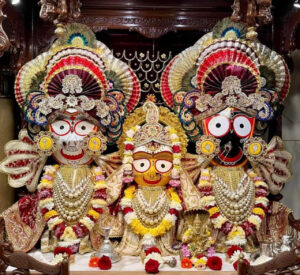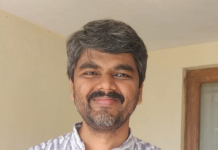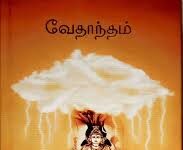 Dear writer
Dear writer
Greetings.
Even though there were some differences of opinion between us, meeting and conversing with you in Dubai was very satisfying. There are many topics to discuss for several more hours and days, but I am content with what we had the other day.
In publicly expressed views, idol worship is presented as one of the major conflicting differences between the Semitic religions and Hinduism. However, from what I have read in the scriptures of the Semitic religions, there are verses that describe God with form. To summarize the perspective of these religions, God is present in His domain (physically). Worshiping idols instead of Him is considered a sin.
On the other hand, according to Hinduism, God is formless. He is the cosmic power, the enigma of the universe. However, He can be worshiped in the form of idols.As Manickavasagar says, “For the one who has no name, no form, singing a thousand holy names, shouldn’t we shower pure devotion?” (“ஒரு நாமம் ஒர் உருவம் ஒன்றுமில்லார்காயிரம் திருநாமம் பாடி தெள்ளேணம் கொட்டாமோ”)
This speaks entirely of the formless God.
What I am asking you is how well this contradiction is understood in the public sphere. What are your additional explanations regarding this?
N. Sivendran
A reminder note: I am a Srilankan Tamil
Dear N. Sivendran,
I very well remember you, your anger and haste too.
You have asked me one of the very insightful questions which I faced recently. A very profound and nuanced one. Thanks.
Such a question doesn’t generally come up in the Indian scenario. One of the main reasons I see for that is that there is no religious education among Hindus here. Nothing of traditional knowledge is taught from a young age here.
In the past, elders in the family would impart some basic religious knowledge to children, such as stories, songs, and rituals. In the past twenty five years, that practice has completely disappeared from our families.
The traditional media for providing religious education were temple arts and folk arts. These too have completely disappeared.
In this context, children here receive no traditional knowledge. They only receive two types of education: one is the technical training provided by schools, and the other is the entertainment education delivered through media.
For the average Hindu, familiarity with the fundamental aspects of Hinduism is very limited. Youngsters who can narrate the Ramayana or Mahabharata in fifteen minutes are extremely rare. In this situation, it’s even more rare to ask about religious philosophies.
However, religion hasn’t completely disappeared either. Religion is upheld by astrology and rituals. For the average Hindu, religious belief manifests primarily as going to temples based on the advice of astrologers when facing problems.
In contrast, there is a type of aggressive rationalism practiced widely. These rationalists do not understand that rationalism itself is essentially a form of knowledge. Here, rationalism is merely expressed as blunt opinions about everything, without the necessary curiosity or effort to genuinely understand anything.
I have noticed that a significant number of young people from Sri Lanka have a basic understanding of religion and tradition. This is mainly because religious education is integrated into their education system. Specifically, the teaching of Saiva Siddhanta provides them with the training and mindset to grasp the philosophical aspects of religion.
The answer is clearly embedded in your question itself. The Semitic religions have definitively outlined the image of God. The definition that “God created man in his own image” is by far the most definitive explanation given by any religion about the form of God.
In Islam and Christianity, God is seen as a personality. He is always referred to in the masculine form. For Jews, God is the ultimate father figure, the one who created, preserves, and governs everything. He is a strict authority figure with anger. This conception extends and evolves in other Semitic religions as well.
In these religions, God is depicted as having emotions, as an active and responsive being. It is possible to see God directly and hear His voice. All these are not presented as metaphors but are defined directly. Followers of these religions believe them exactly as such.
If that’s the case, why do they reject idol worship? The essence of their religions lies in the divine imagery presented by their founders. Their belief is firmly rooted in the notion that this is the truth and everything else is false. Therefore, they must reject all the diverse divine experiences and representations that have been conceptualized in various forms and perspectives on this earth.
They reject idol worship precisely for this reason. It is an approach that rejects all other representations except their own.
To understand this easily, one just needs to ask a few questions. If they reject idol worship, would they accept an Advaitin or a Theravada Buddhist who completely does not practice idol worship? They would not.
For both Advaitins and Theravada Buddhists, the divine imagery proposed by these religions is not acceptable. They would consider the definitions of divine power given by these religions as ignorance. Therefore, they would be deemed blasphemers by the followers of these religions and persecuted. So, the issue is not idol worship itself. It is about others accepting the specific imagery and representation these religions propose.
The divine imagery that forms the essence of Indian religions is entirely formless. The Brahman presented in the Vedas is beyond description, demonstration, or definition in any way. All the qualities attributed to Brahman point to this transcendental nature. It is described as that which cannot be spoken of, seen, or explained.
Brahman is referred to as “that.” It is neither masculine nor feminine. No human attributes are ascribed to it. It is not a personality, an entity, or an existence. It is merely a vast cosmic reality that we perceive as a subtle awareness.
The Vedas describe the vision of Brahman using both logical and poetic language in the Upanishads. They attempt to describe it without attributing any specific form or symbol. Brahman, as we understand it, is a subtle self-awareness (Pragnānam Brahma), a sense of the vast cosmos (Īśāvāsyam idaṃ sarvaṃ), and an infinite cosmic consciousness (Aham Brahmāsmi).
We can also find this subtle divine imagery in the Buddhist tradition. Their concept of divinity is the fundamental principle underlying this universe, which they refer to as Mahādharmā.
It is this same spirituality, which perceives the divine as entirely formless, that also defines the divine as being present in all forms. All forms are, in essence, manifestations of the formless divine. All names are, in essence, names of the nameless divine.
Declaring that Hindu spirituality is all about idol worship, is a complete misunderstanding. Idol worship refers to the worship of specific forms or symbols as sacred or divine. Hindu spirituality, on the other hand, considers all forms and symbols as manifestations of the divine. It views any form of worship as divine worship. This is not idol worship but worship of the totality. If needed, it can be called cosmic worship.
I have written about this paradox before. In any Hindu hymn, one line depicts the divine as formless, infinite, and beyond comprehension. The next line depicts the divine as having a form, something knowable. The essence is that I worship ‘It’ (the unknown) in this way.
In other words, the symbols given to the divine in the Hindu spiritual knowledge tradition do not originate from the limits of the divine but from the limits of our understanding. Any Saiva Siddhantin knows that Shiva is not merely the man, the axe, the serpent, the ashes, or the tiger skin. He understands Shiva as “one who is beyond comprehension by all in the world.” He would describe it as an eternal dance that embodies the essence of this universe, a manifestation of infinite power.
But he thinks that the formless should manifest, in the pooja room in his home, as a golden figure dancing with his raised left foot (referring to the Nataraja statue). This becomes a necessity since human consciousness can only think and meditate upon the formless through a form alone.
Yes, that form is created by his vision and thought. But since that very wisdom which creates is also Him, that form is just a dance of the formless for him.
Jeyamohan.
Translated By Geethaa Senthilkumar










